Blog
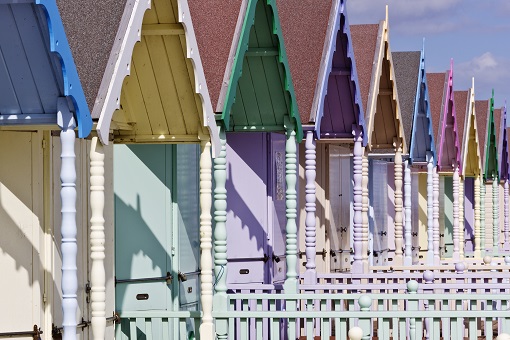
Tiny House Roofing – How To Strike A Balance Of Strength & Style?
Do you want to know what is the best tiny house roofing option?
After all, the number of options for a roof exceeds overwhelmingly. From style to material, the struggle to choose the right one is REAL.
While all styles and materials serve different purposes, we decided to find what are different options for roofing tiny houses. And which type of roof is perfect for your tiny house.
What Are The Most Common Types Of Roofing For Tiny Houses?
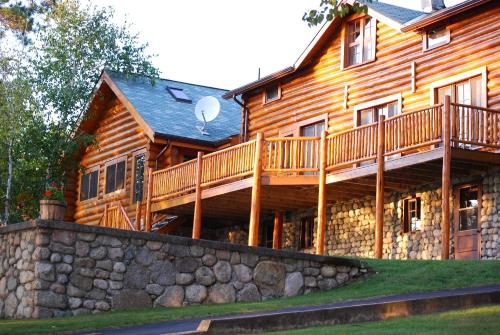
Your tiny house can have a variety of options for roof styles. You can choose a style purely for aesthetics, or something that provides a bit of purpose for your roof, like improved access to natural light. Additionally, consider the amount of headroom ad pitch that your loft bedroom will require.
Here are some of the most common roof styles for tiny houses:
1. Shed roof
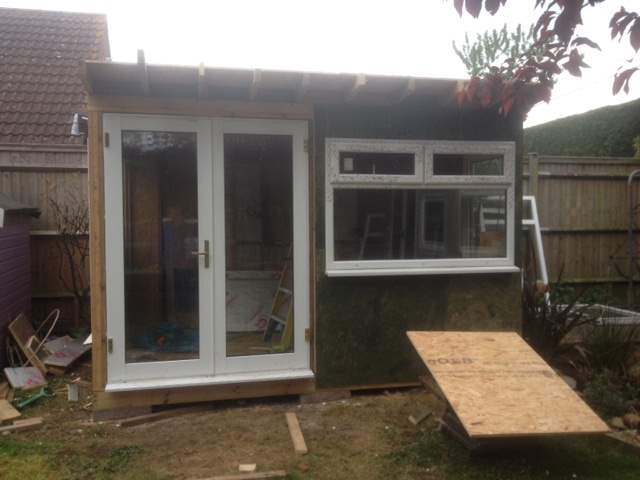
The shed is a single-pitched roof style that isn’t attached to another roof shell. it maximizes the vertical surface of the roof and can extend to a maximum legal road height of 13ft.
A shed roof has an easy installation and can be built with DIY kits. If you have an upper hand for handwork, this could be your next project.
What we like
- A great choice for a loft or attic area.
- Can provide a good source of natural lighting.
- Good for harvesting rainwater.
What we don’t like
- Hard to get rid of snow.
- A heavy metal roof is needed with a heavy pitch.
- You normally can’t build a massive house with a flat roof (flat roofs are indeed for tiny homes). This means smaller rooms, appliances and washroom.
2. Saltbox roof
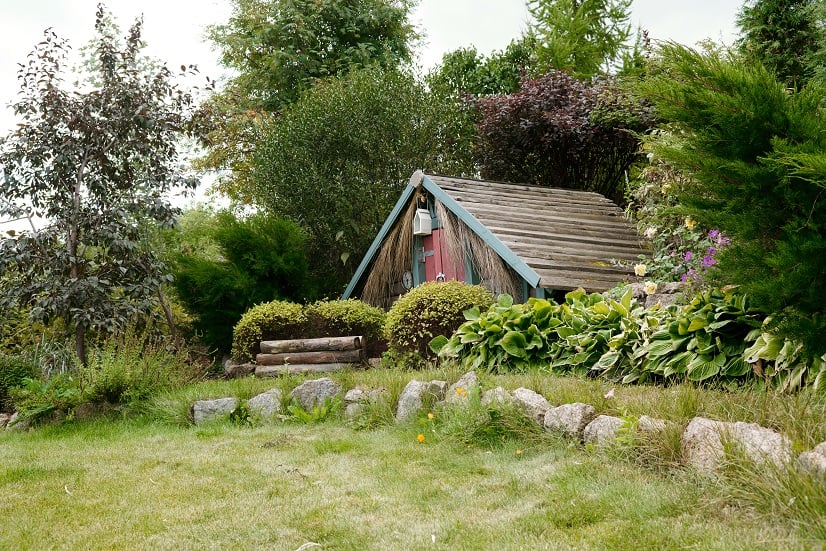
Saltbox roof has a similar concept to a shed roof. The focal difference is that the saltbox has two sides, one long and one short side.
A saltbox is a bit more complicated to install than a shed, so best to take help from a professional handyman.
What we like
- Smooth water runoff.
- Space can be made available for a skylight instead of a window.
What we don’t like
- The acentric middle can cause uneven distribution of weight.
- Fortified end walls and structural reinforcements are needed to anchor the roof.
3. Gambrel Roof or Barn Style Roof
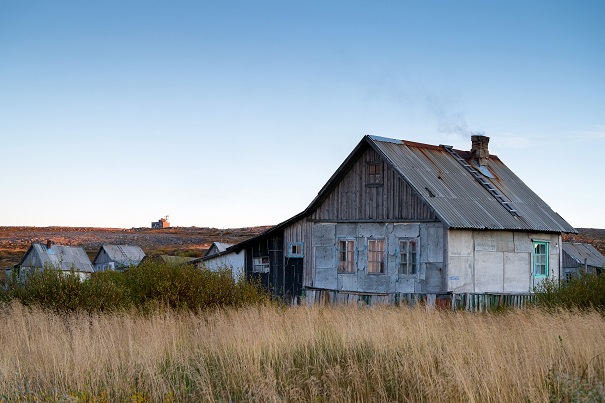
Gambrel is the most common roof style you see on most barns. It is also a common style of roof for tiny houses.
It has a centered middle and two symmetrical sides. Each side consists of one shallow slope and one steeper slope.
What we like
- It makes a strong and solid structure.
- Leaves room for a loft with more headroom.
What we don’t like
- It is very difficult and complicated for DIY projects.
- Every joint must be reinforced for utmost strength.
- A variety of materials are required to build.
4. Gable Roof
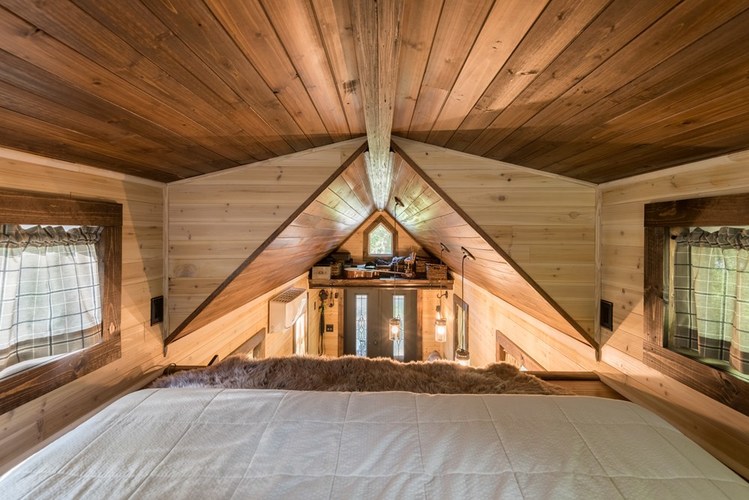
It is the most typical roof style for tiny houses and most traditional homes. It consists of two equally sloped sides connected in the middle making the perfect opposite “V” shape for a roof.
It is a simple roof style, and anyone with decent construction skills can make this.
What we like
- Weather resistant, meaning no worries about snow or heavy rainfall
- You can build it yourself without much problem
What we don’t like
- Doesn’t maximize space for a loft or attic.
- Needs reinforcements for the structure to increase its strength.
- Does not leave room for a loft (unless you multiple roof types like in the picture above)
5. Flat roof
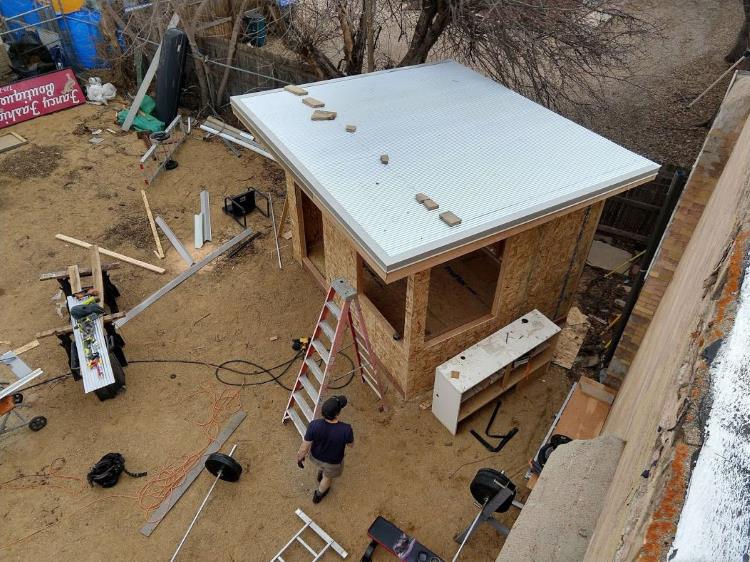
Just like the name, a flat roof is a completely flat surface without a pitch. It is a much more aesthetically pleasing roof style because of the straight clean surface.
It is easy to construct and can be constructed without any hassles.
What we like
- Provides a sleek and clean look for a roof.
- Easy to construct.
What we don’t like
- High maintenance potency. Can build debris and waste over a long time.
- It is not suitable for a choice of areas receiving heavy snowfall.
6. Arched or rounded roof
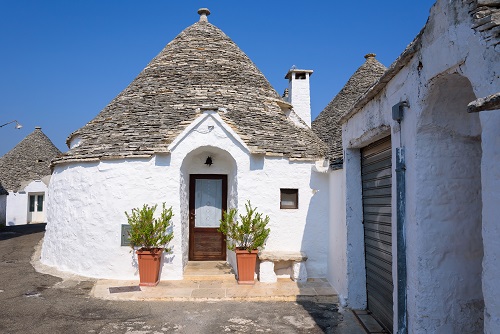
Arched is a common roof style used mostly for caravan wagons. It is a unique design that also possesses high strength and sturdiness.
The construction of an arched roof, however, is much more complicated and complex. It is always a good choice to hire a professional for this job.
What we like
- Strong and unique roof style.
- Weight is evenly distributed.
- Weather and water-resistant.
What we don’t like
- Construction is highly complicated.
- Is not suitable for a DIY project.
What Are The Best Roofing Materials For Tiny Houses?

Plenty of roofing materials are available in the market, but only a few are suitable for tiny houses. Most of these materials make too heavy of a structure for a tiny house.
The best materials for a tiny house are asphalt shingles, metal roofing panels, and ceramic tiles.
Asphalt Shingles (Average Cost: $100-$160 Per Square)
Asphalt shingles are a common type of material used in tiny house roof installations. Shingles are available in different materials, but asphalt is the most suitable for roofing in tiny houses.
Asphalt shingles are easy to install and come in a wide range of colors. They are a popular choice because of their durability to withstand minor weather changes.
If you are considering asphalt shingles, denote the weather conditions of your area. Asphalt shingles have the tendency to crack under extreme temperature changes.
Asphalt shingles are not recyclable and require a lot of energy to produce, hence, it’s not the greenest material for roofing.
Pros of installing Asphalt Shingle
- It is comparatively an inexpensive choice for roofing.
- It is suitable for different styles, as they come in different colors and textures.
- Installation is quite uncomplicated for asphalt shingles.
- Replacing asphalt shingles can also be done trouble-free.
Cons of installing Asphalt Shingles
- Asphalt shingles are susceptible to strong winds. Cheaper-quality shingles may crack and even detach in some cases.
- They are vulnerable to extreme weather changes and can fissure when exposed to extreme heat.
- They need to be installed in a warmer temperature.
- They are not as long-lasting as other materials.
Ceramic Tiles (Average Cost: $2 – $12 Per Square)
Ceramic tiles can provide an eccentric look to your tiny house. Ceramic tiles are made of clay, concrete, or terracotta, and are the most environment-friendly roofing material.
They have the tendency to be extremely long-lasting at the right temperature. Ceramic roofing can even withstand weather conditions such as hail, high winds, and even external fires.
Ceramic tiles are most preferred because of their low maintenance. They are also leak-proof, immune to rotting and damage caused by house bugs.
Pros of installing ceramic tiles
- Ceramic tiles are weather-resistant. They are most effective for hurricane-prone areas.
- They are eco-friendly and help in reducing energy costs.
- They need minimal maintenance and are highly durable.
- Ceramic tiles can last a lifetime in a constant climate.
- They come in contrast options from clay or concrete and different styles.
Cons of installing ceramic tiles
- Ceramic tiles are a very heavy roofing material and can cost twice as much as other materials.
- They are also complicated to install and require specialty flashings for correct installation.
- Even after being weather-resistant, ceramic tiles can be brittle and can still crack and break if impacted by heavy damage.
- These tiles are also gullible for algae growth. They need to be washed with rain algae prevention solutions to keep the tiles clean.
Metal Roofing (Average Cost: $80-$360 Per 100 Square Feet)
Metal roofing installations are exceptionally lightweight and long-lasting. It can resist water, snow, fire, mold, and bugs.
They are also relatively easy to install and come in a variety of options. Irrespective of the choices copper and aluminum remain the most popular choices because of their affordable cost.
Most of the steel installations are heavy-duty and rustproof and can survive heavy rain and hail storms. There are galvanized steel and galvalume steel installations available that can resist corrosion.
While galvalume steel roofing is more expensive, it can be a more persistent choice than galvanized roofs.
Pros of installing metal roofing
- The longevity of metal roofing can outgrow any other roofing material.
- It is more durable and easy to install.
- Metal roofings are also fire-resistant and can withstand wildfires and lightning strikes.
- They tend to reflect UV and infrared rays from the sun causing less surface heating and leading to a reduction in cooling costs.
- Most of the metal roofings are made from 10-30% recycled materials making it perfect for eco-friendly living. They are also fully recyclable at the end of their lifespan.
Cons of installing metal roofing
- Metal installations are not the most affordable choice of roofing.
- During rain or hail, they tend to create a lot of noise. So, Insulation may be required to solve this problem.
- Fixing metal roofing can be quite a challenge as the same color metal panels may not be available causing inconsistency in the color of the roof.
- Some metals can be poorly made and may have a thinner gauge. Some of them can even rust in certain climates and dent easily during hail.
How To Build A Tiny House Roofing System?
Let us be honest, installing your tiny home’s roof can be a no-easy task. In fact, it is actually quite complex and requires a number of steps.
Step 1: Prep The Roof With Underlayment
Before laying down the actual roof, you need to prep your roof with the use of tar paper. Tar paper is used to add a weather-resistant layer that protects your house from rain, moisture infiltration, and dirt.
You need to cover the entire surface of the roof sheathing, so measure and cut the tar paper according to that. The paper is then installed going from the bottom to the top of the roof pitch.
This chronology is important to ensure natural drainage as the layer seals the water from entering the house.
Step 2: Installation Of Drip Edge
A drip edge is a bent metal sheet that helps drive the water away from the roof. A drip edge is added at the bottom of the underlying for proper flow of water.
Step 3: Install The Roofing Panels
This is the process where you add the topmost layer of your roof. You must begin by adding the sealant on the drip edge.
Then you must lay your roofing panels by lining them up with the edge of the roof sheath. Let the roofing panel overhang by 2 inches to let the water drip away.
For fastening the bolts on the roof, always refer to the manufacturer’s illustrations on installations.
Repeat the aforementioned procedures until the entire roof is covered and securely connected, then overlap the rip panels at the edges.
Step 4: Install Gable Flashing Trims
Add gable flashing trims with a strong sealant for a 100% water-resistant roofing system. You might want to take help from your family or friends, as this part can be a bit tricky.
After that, install the outside closure trims and peak flashing. Then add the final screws and bolts, that hold everything together in place, and your roof is ready.
FAQs – Tiny House Roofing
What is the best material for the roof of a tiny house?
Without a second opinion, metal roping is the best type of tiny house roofing. There are plenty of reasons to support our statement.
Metal is fire-resistant, water-resistant, and weather-resistant and increases energy efficiency. Most metal roofs are everlasting and can outlive any other material roofing.
What is the cheapest material to replace a roof?
Asphalts shingles are the cheapest and the most cost-effective roofing material if want new replacement roof panels. Asphalt shingles come in three different variants which differ in quality and price.
What is the easiest roof to install?
Shed style is the easiest roof to install. It s one of the few roofings, homeowners can do themselves. A shed is a versatile roof style that can be particularly suited for many building structures including garages, barns, stables, and even tiny houses.
What is the best roof to prevent heat?
Terra-cotta ceramic tiles and metal roofing are two of the best roofing materials to prevent heat. Ceramic tiles can provide a layer of insulation and keep the heat from penetrating through the surface. While metal roofing can reflect UV and infrared rays responsible to increase heat. Hence, making it the most energy-effect material of all.
So, Which Roof Will Land On Your Head?
Remember, first consider the style of roof you want for your tiny house. Consider factors like wind resistance, fire resistance, headroom, and the kind of lighting you want.
After that choose the suitable material for your region and environment. If the area you live in experiences extreme temperature changes, avoid using asphalt shingles and ceramic tiles.
And, if you want an evergreen roof that will last for generations, consider getting a metal roof installed. This is it for small house roofing styles. Thank you for reading, we hope this information was helpful.